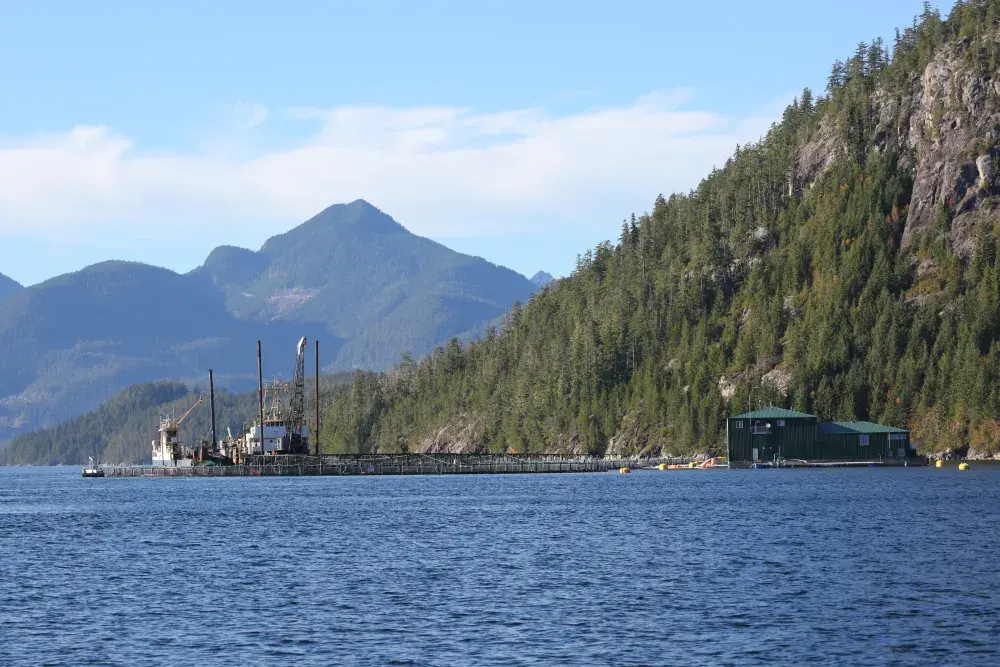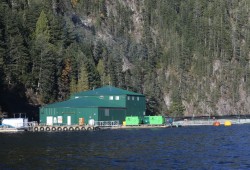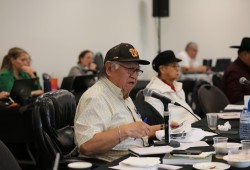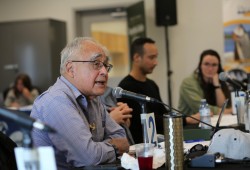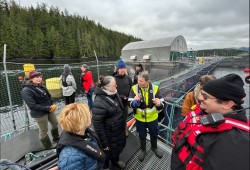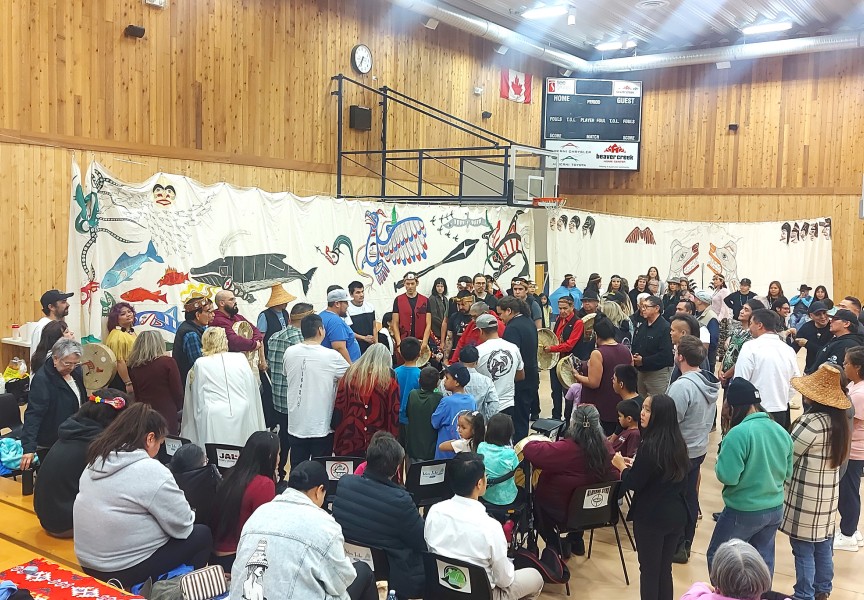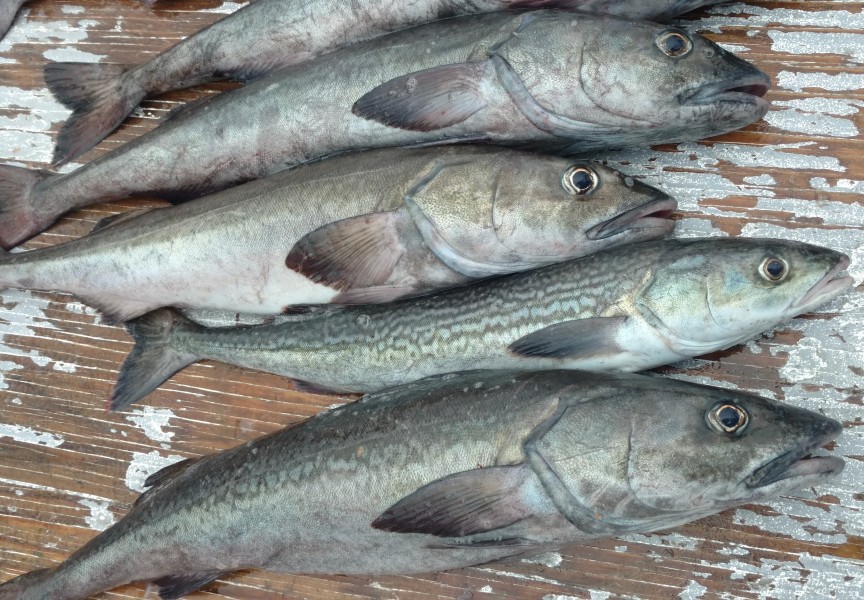With the 2025 deadline approaching for a transition plan from the standard ocean net pens, the fish farming industry is on the cusp of a defining period as all of B.C.’s tenure licences are set to expire this summer.
According to data provided by Fisheries and Oceans Canada, all of the 85 finfish licences on British Columbia’s coast are due to expire June 30. Renewals are being sought for 66 of these licences, and consultations are underway with First Nations that have fish farms in their territorial waters.
“All nations that have marine finfish in their territories should have received a consultation package on the marine finfish conditions of licence and licence reissuance,” said Amber Neuman, DFO’s senior aquaculture management coordinator, during a Nuu-chah-nulth Council of Ha’wiih Forum on Fisheries meeting on Feb. 22. “That engagement and consultation is going on until March 8.”
“We’ve really gone back in time. I say that because I heard ‘consultation’ used seven times when I started counting,” commented Nuchatlaht House Speaker Archie Little after hearing Neuman’s update during the meeting. “We’re at the point of consent. We have talks, we negotiate, we come to an agreement and we consent. To me, consultation is you coming into our communities, telling us what you’re going to do, and then leaving again.”
“We understand that this is an important topic for many First Nations and we want to respect the many views that come along with aquaculture,” said Neuman during her address to the Nuu-chah-nulth representatives.
Even if the 66 operational permits are renewed, Neuman noted that no additional licences will be granted this year. The industry awaits the result of a mandate from Prime Minster Justin Trudeau to “create a responsible transition plan from open net-pen salmon farming in coastal British Columbia waters by 2025.” A draft of that plan is expected to be released this year.
“At this point our director general has made the decision to pause all applications for any biomass increase or new facilities in British Columbia until the transition plan comes out,” said Neuman.
Closures threaten Ahousaht’s ‘rights as a nation’
Very little is known about what this transition plan will look like, but in an interview with Ha-Shilth-Sa in December Fisheries Minister Dianne Lebouthillier said that it will not mean the immediate shutting down of more salmon farms.
“In the mandate letter, I’m asked to put in place a transition plan. It doesn’t say that we have to close everything, that we have to close all the aquaculture centres. It really means working to put in place measures to protect wild salmon,” said Lebouthillier in French. “I’ve confirmed that there will be no closure of aquaculture centres in 2025. We’re going to present a transition plan, and then we’ll go from there.”
At stake is an industry that directly supports 7,000 jobs in coastal communities, contributing $1.5 billion to the province’s economy annually, according to the B.C. Salmon Farmers Association.
Of the existing 85 finfish licences, 52 are in Nuu-chah-nulth territory off the west coast of Vancouver Island, from Barkley Sound to Kyuquot. The majority of these sites raise Atlantic salmon – a long-held staple of the fish farming industry – with a few exceptions, like two sablefish farms operated by Golden Eagle and a chinook site run by Mowi in Kyuquot Sound.
Most of the 21 sites in Clayoquot Sound are operated by Cermaq, although not all are stocked at one time, with some areas requiring that no more than four of six sites are to be in use.
For over a decade Cermaq has operated under a protocol agreement with Ahousaht, which entails environmental requirements, employment, educational supports, transportation and other benefits for the First Nation’s members, which are currently valued at approximately $6 million annually. Twenty-one Ahousaht members work at Cermaq’s operations in Clayoquot Sound, including the processing plant, saltwater farms and support roles.
In an opinion piece published in iPolitics late last year, Ahousaht Acting Tyee Ha’wilth Hasheukumiss, Richard George, stressed the importance of the federal government respecting his nation’s right to determine who operates in their Ḥahuułii.
“Closing aquaculture facilities doesn’t only fly in the face of our rights as a nation. It means devastating job losses, food security concerns, and increased daily costs for Ahousaht musčim,” wrote Hasheukumiss. “It also threatens existing economic partnerships and agreements with aquaculture operators, undermining governance and economic stability.”
With limited employment opportunities for the Flores Island community, it’s a difficult issue for Ahousaht members to balance.
“They do impact wild stocks, no doubt in my mind,” said Cliff Atleo, who is chair of the fisheries forum, during the Feb. 22 meeting. “I get caught between a rock and a hard place, because I know the negative impacts of fish farms, but I also see the benefits that flow to our people wouldn’t be there normally.”
Atleo, who is an Ahousaht member, noted that Cermaq has responded faster to the First Nation’s concerns about aquaculture than DFO.
“The story that most people don’t understand is the revenues that are generated from their operation there, along with provisions within the agreement,” he said, noting that Cermaq supports operations of the Maaqtusiis Hahoulthee Stewardship Society, which is run by Ahousaht Ha’wiih. “They pay for halibut fisheries, MHSS, from revenues of that fish farm. We wouldn’t have some of these benefits without those revenues.”
Resurgence in pink salmon disputed
For many years fish farms have faced scrutiny as Pacific salmon stocks have declined. Many fear that the close quarters of net pens serve as a breeding ground for sea lice and other pathogens, exposing migrating wild salmon to disease.
Amid these concerns, a number of farms have been removed from regions off the northeast coast of Vancouver Island in recent years, including 15 sites in the Discovery Islands and 17 farms in the Broughton Archipelago.
While the three-day Council of Ha’wiih Forum on Fisheries was underway, leaders from Broughton First Nations visited Port Alberni to give a presentation on their fight to remove the salmon farms. After years of tensions, the situation came to a confrontation when ‘Namgis members occupied a salmon farm in August 2017.
“Things came to a head,” said Ho’miskanis, Don Svanvik, hereditary and elected chief of the ‘Namgis First Nation. “They became year-round hosts for sea lice.”
“It’s a devastating industry,” added Chief Councillor Rick Johnson of the Kwikwasut’inuxw Haxwa’mis First Nation. “Our clam diggers were starting to notice our beaches weren’t the same, things were changing, and they attributed it to the fish farms.”
The occupation brought a visit from former premier John Horgan, who facilitated meetings between the province, the three First Nations from the area, as well as aquaculture companies Cermaq and Mowi.
Unsatisfied that there was evidence to show the farms weren’t harming wild salmon, the 17 sites were closed, and the last of them was removed from the Broughton in 2023.
With the farms out of the ocean, a healthy run of pink salmon passed through the Salish sea last year, resulting in approximately 20 million returning to the Fraser River, the largest migration to the watershed since 2003.
“They’re coming back, it’s proof that this industry had a devastating impact on our salmon,” said Johnson. “For the first time in a long time some of the killer whales are showing up in the Broughton. I think it’s been 20 years since we’ve seen some of them.”
“Salmon is an amazing species,” commented Svanvik. “All we have to do is get out of the way.”
Meanwhile industry advocates have disputed a correlation between a resurgence of pink salmon and the removal of fish farms from the region. The B.C. Salmon Farmers Association presented data from DFO records, showing wild variations in pink returns since 1969. These range from under 5 million to the 24 million in 2003, with no apparent change to the pattern when salmon farms came to the waters northeast of Vancouver Island in 1988.
“The pink salmon’s success has nothing to do with local impacts and everything to do with global ocean conditions favouring the pink salmon,” stated the BCSFA.
The association has also disputed concerns that sea lice from the Discovery Islands farms impacted wild salmon.
“Professional biologists have consistently measured the abundance of sea lice on wild juvenile salmon at the same locations for the past seven years in the Discovery Islands region,” said Brian Kingzett, executive director of the BC Salmon Farmers Association, in a release. “The data shows that the sea lice abundance on juvenile wild salmon in 2022 was about 50 per cent less than in 2020, however, that was the case both before they reached salmon farms and after they passed by salmon farms. Furthermore, 2022 sea lice levels were similar to 2017 and 2018 when all farms were active in the Discovery Islands region.”
For those on either side of the issue, it’s been difficult to read the DFO’s position on salmon farms. In February 2023 the federal department announced the permanent closure of 15 sites in the Discovery Islands, which are located south of Broughton, citing adverse impacts to wild stocks. But meanwhile Lebouthillier’s recent comments indicate that dozens of other licences could be renewed this summer.
“I’m just curious about the government’s formal position on why they seem to keep it alive,” said Atleo of DFO’s management of the industry. “A transition plan to what? What are they transitioning to? Sanity, hopefully.”

